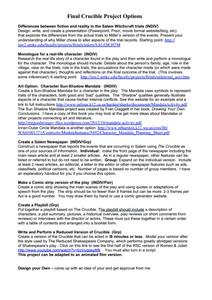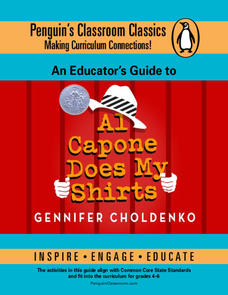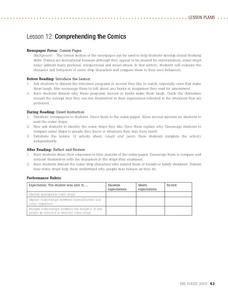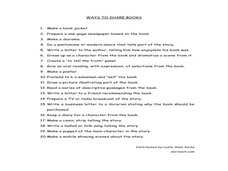Curated OER
Study Guide for Missing May
Use this comprehensive packet to accompany a study of Missing May by Cynthia Rylant. Starting out with a brief author biography and background information about the novel, this guide includes materials to use throughout the entire novel....
Curriculum Corner
Fiction Graphic Organizers
Get an in-depth look into a narrative text with a three-page worksheet that examines a story's character—actions, sayings, thoughts, and appearance—setting, and challenges scholars to write a brief summary about what they've read.
Curriculum Corner
Fiction Graphic Organizers
Analyze a fictional text with a four-page packet that explores a story's main character and moral, challenges scholars to ask and answer questions about the text, and to create a story map.
Curated OER
Charlotte's Web
Students complete a variety of activities related to the book "Charlotte's Web" by E.B. White. They create a comic strip based on the characters, setting, and plot of the story, and examine the author's writing process. In small groups...
Curated OER
Pop Art Lesson Plans
Pop art lesson plans help students understand the meaning of art and how it relates to society.
Curated OER
New York State Testing Program: English Language Arts Listening Test Selection Grade 7
Although labeled as a listening test, no questions accompany Jim Davis’ "Flight of Fancy," a short essay in which he describes how he came to be a cartoonist and the creator of Garfield. However, the article is interesting and crafting...
Curated OER
Using Adjectives
For this language arts lesson, students listen to the book "Many Luscious Lollipops," in order to become familiar with adjectives. Students create four comic strip squares, using five adjectives in each square, after
hearing the book....
Curated OER
A Connecticut Yankee in King Arthur's Court
Students create a presentation in which they retell the events of A Connecticut Yankee in King Arthur's Court. In this A Connecticut Yankee in King Arthur's Court activity, students are introduced to Mark Twain in a PowerPoint, then...
Starfall
Lemonade Girl
Let your students' inner comic book artists emerge in this fun activity, which provides a word bank of twenty-seven words to be used in a story about what kids want to do when they grow up. Opportunities to illustrate their ideas, as...
Curated OER
Final Crucible Project Options
Finding and/or designing a menu of equally weighted synthesizing projects to end a unit can be a challenge. Simplify the task with this menu of individual and group projects meant to accompany a study of The Crucible. Presentations,...
For the Teachers
Sequence Plot Chart
Your kids can identify the plot sequence of a short story, but what about an informational article? Have them examine the chronological order of events in informational texts with a lesson on the sequence of events.
Penguin Books
An Educator's Guide to Al Capone Does My Shirts
It's hard to imagine that life on Alcatraz could be dull. A series of intriguing lessons take readers through the novel Al Capone Does my Shirts. Pre-reading questions introduce the text and a range of suggestions, from comic strips to...
Curated OER
Comprehending the Comics
Learners discuss and examine the comic strip section in newspapers. They compare and contrast themselves and others with the comic strip characters. With partners, they select a comic strip and complete a student activity sheet.
Curated OER
Ways to Share Books
In this book report idea sheet, students are given a list of 20 possibilities for creating a non-traditional book report (e.g., making a diorama; making a poster).
Curated OER
Superhero Comic Strip Using Greek and Latin Roots
Learners create comic strips in groups and explain to the class the Latin and Greek roots of their superhero names. In this Latin and Greek root lesson plan, students get into groups and come up with superhero characters to integrate...
Wiley Publishing
Anatomy and Physiology Workbook
Peruse a workbook for every system in the human body. From cellular makeup to the integumentary system to human reproduction, the 300-page workbook features informative reading passages, guided practice, and humorous comic strips to get...
Harper Collins
If You Give...Series Teaching Guide
If you give teachers a few good ideas, they can really bring a story to life. Included in this resource are dozens of activities to use as your class reads books in the If You Give... series. From holding puppet shows and creating...
Curated OER
Narrative Writing
Students create new sentences using adverb clauses identified from a book. In this narrative writing lesson, students write new sentences from some of the dependent clauses used in a book read to them by the teacher. Students...
Do2Learn
Sequencing Chart
Take note of events in a story with this organizer. Learners write down the who, what, where, and when, writing down four events in the order that they occur.
Curated OER
Eudora Welty's "A Worn Path" in Graphical Representation
Students analyze graphical forms of Eudora Welty and interpret the shorts stories in the representations. In this graphical representations lesson, students analyze the short story genre in comic strips. Students then create their own...
Curated OER
Robert Indiana Biography, Activities, and Lesson Plans
Students analyze Pop art and the work of Robert Indiana. In this Pop art lesson, students read about the history of Pop art and a biography of Robert Indiana. Students complete a criticism and aesthetics activity, create their own Pop...
Curated OER
???The Hell of Mirrors??? by Edogawa Rampo
Students read and analyze the story "The Hell of Mirrors," by Edogawa Rampo. They watch a video excerpt, answer discussion questions, construct a periscope, complete handouts, define key vocabulary terms, take a quiz, and write a book...
Curated OER
Story Elements
Third graders identify story elements. In this story elements lesson, 3rd graders look at main idea, characters, point of view, theme and setting. They create a five paneled comic strip from a book.
Curated OER
Adding Snap to Language Arts
Students take photographs of themselves, animals, and objects and used these photos as springboards for writing stories, plays, photo captions, comic strips, ads for products, and greeting card messages.

























